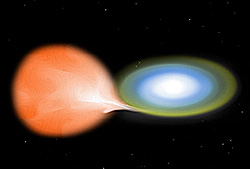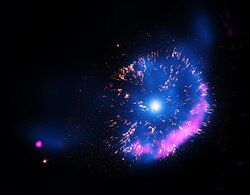Nova
A nova (plural novae or novas) is a huge nuclear explosion on a white dwarf star. It causes a sudden brightening of the star.
Novae are not to be confused with other brightening phenomena such as supernovae. Novae occur on the surface of a white dwarf in a binary system. If the two stars of the system are close enough, material is pulled from the companion star's surface onto the white dwarf. This collection of hydrogen onto the surface of the star starts a runaway fusion reaction.[1]
In spite of their violence, the amount of material ejected in novae is usually only about 1⁄10,000 of a solar mass, quite small relative to the mass of the white dwarf. Only five percent of the accreted mass is fused during the power outburst. This is enough energy to make nova ejecta to go outward as fast as several thousand kilometers per second—higher for some novae than others. The star also brightens, from a few times solar to 50,000–100,000 times solar. In 2010 scientists using NASA's Fermi Gamma-ray Space Telescope were surprised to discover, for the first time, that a nova can also emit gamma-rays (>100 MeV).[2]
A white dwarf can potentially generate multiple novae over time as additional hydrogen continues to accrete onto its surface from its companion star. An example is RS Ophiuchi, which is known to have flared six times (in 1898, 1933, 1958, 1967, 1985, and 2006). Eventually, the white dwarf could explode as a type Ia supernova if it approaches the Chandrasekhar limit.
Occasionally a nova is bright enough and close enough to be seen by the unaided eye. The brightest recent example was Nova Cygni 1975. This nova appeared on 29 August 1975, in the constellation Cygnus about five degrees north of Deneb and reached magnitude 2.0 (nearly as bright as Deneb). The most recent were V1280 Scorpii, which reached magnitude 3.7 on 17 February 2007, and Nova Delphini 2013. Nova Centauri 2013 was discovered 2 December 2013 and is so far the brightest nova of this millennium reaching magnitude 3.3.
Astronomers estimate that the Milky Way experiences roughly 30 to 60 novae per year, with a likely rate of about 40.[3] The number of novae discovered in the Milky Way each year is much lower, about 10.[4] Roughly 25 novae brighter than about magnitude 20 are discovered in the Andromeda Galaxy each year and smaller numbers are seen in other nearby galaxies.[5]
Nova Media
GK Persei: Nova of 1901
Nova in Andromeda Galaxy
References
- ↑ Darnley M.J. et al 2012. On the progenitors of galactic novae. Astrophysical Journal 746 (61). [1]
- ↑ JPL/NASA 2010. Fermi detects 'shocking' surprise from supernova's little cousin. PhysOrg. [2]
- ↑ Prialnik, Dina 2001. Novae. In Paul Murdin (ed) Encyclopedia of Astronomy and Astrophysics. Institute of Physics Publishing/Nature Publishing Group. pp. 1846–1856. ISBN 1-56159-268-4
- ↑ "CBAT List of Novae in the Milky Way". IAU Central Bureau for Astronomical Telegrams.
- ↑ "M31 (Apparent) Novae Page". IAU Central Bureau for Astronomical Telegrams. Retrieved 2009-02-24.



